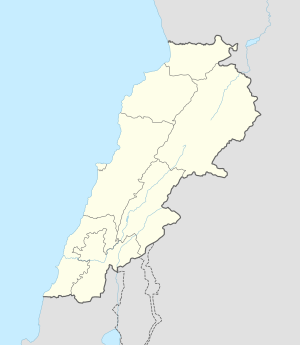Sarafand, Lebanon
Sarafand
الصرفند | |
|---|---|
 Glassmaking in Sarafand | |
 Flag | |
 Sarafand Location in Lebanon | |
| Coordinates: 33°27′06″N 35°17′27″E / 33.45167°N 35.29083°ECoordinates: 33°27′06″N 35°17′27″E / 33.45167°N 35.29083°E | |
| Country | |
| Governorate | South Governorate |
| District | Sidon District |
| Government | |
| • Type | Mayor–council |
| Elevation | 70 m (230 ft) |
| Population (2004) | 10,965 |
| Time zone | UTC+2 (EET) |
| • Summer (DST) | UTC+3 (EEST) |
| Dialing code | 00961 (7) Landline |
Sarafand (Arabic: الصرفند) is a village in southern Lebanon located 10 km south of Sidon overlooking the Mediterranean Sea.
Its name conserves that of the Phoenician site of Sarepta, just north of Sarafand.[2]

Sarepta and Sarafand in the 1862 Carte du Liban
History[]
In 1875 Victor Guérin noted that the village had 400 Métualis inhabitants.[3]
References[]
- ^ Sarafand, Localiban
- ^ Nicolas Carayon (2012–2013), "Les ports phéniciens du Liban" (PDF), Archaeology& History in the Lebanon Issue
- ^ Guérin, 1880, p. 482: "A sept heures, j'examine, en me dirigeant vers l'est-sud-est, quatre anciens tombeaux pratiqués dans le roc, sur les pentes de la colline que couronne le village de Sarfend. Un peu plus loin, vers le sud, on remarque une antique carrière et une grande caverne, qui, au dire des habitants du pays, est très étendue; actuellement l'entrée en est obstruée par d'énormes blocs tombés de la voûte. On l'appelle Merharet ei-Haloueh. De là, je monte à Sarfend. Ce village a une population de 400 Métualis. Il a hérité, mais en le modifiant un peu, du nom de Sarepta, ville à laquelle il parait avoir succédé, mais sur un autre emplacement, quand celle-ci a été détruite. Redescendant bientôt vers le sud, je rencontre, un kilomètre plus loin, d'autres tombeaux creusés dans le roc et divers débris de sarcophages."
Bibliography[]
- Guérin, V. (1880). Description Géographique Historique et Archéologique de la Palestine (in French). Vol. 3: Galilee, pt. 2. Paris: L'Imprimerie Nationale.
External links[]
- Sarafand, Localiban
Categories:
- Populated places in Sidon District
- Populated places in Lebanon
- Shia Muslim communities in Lebanon
